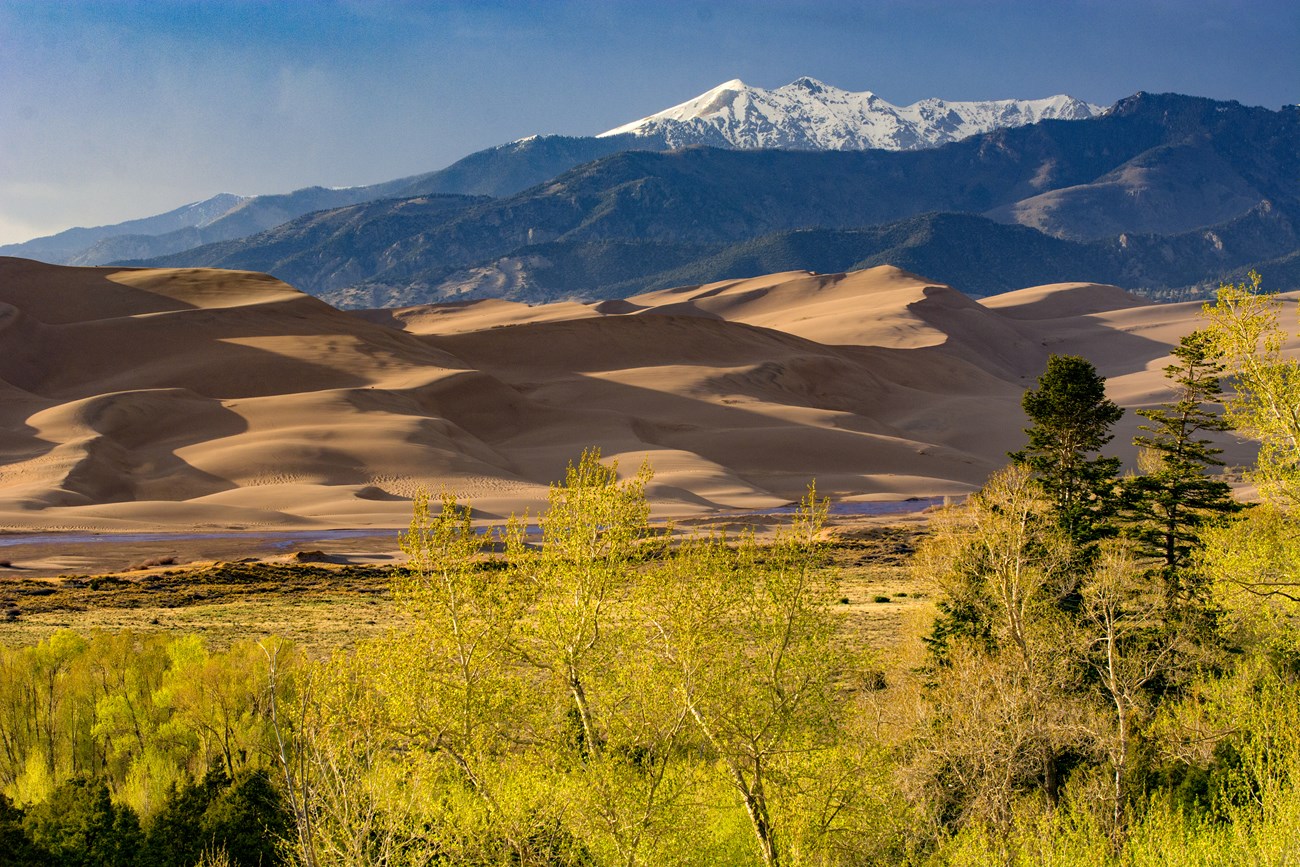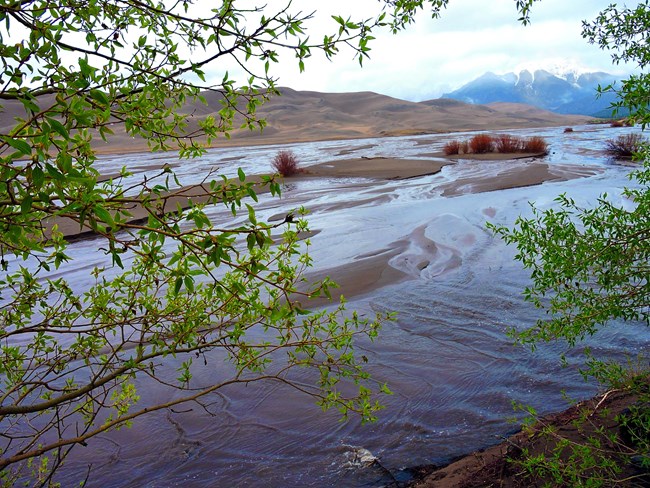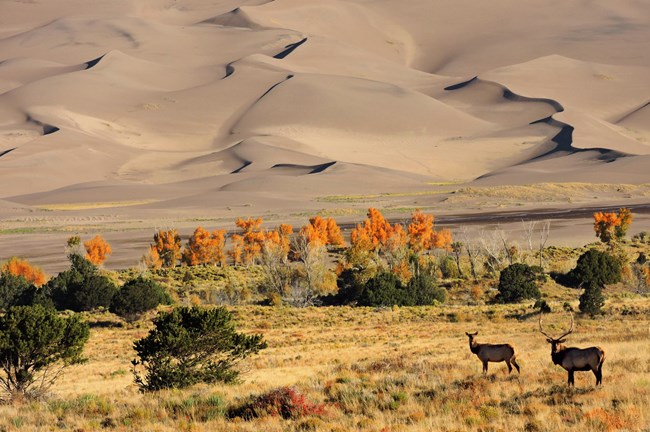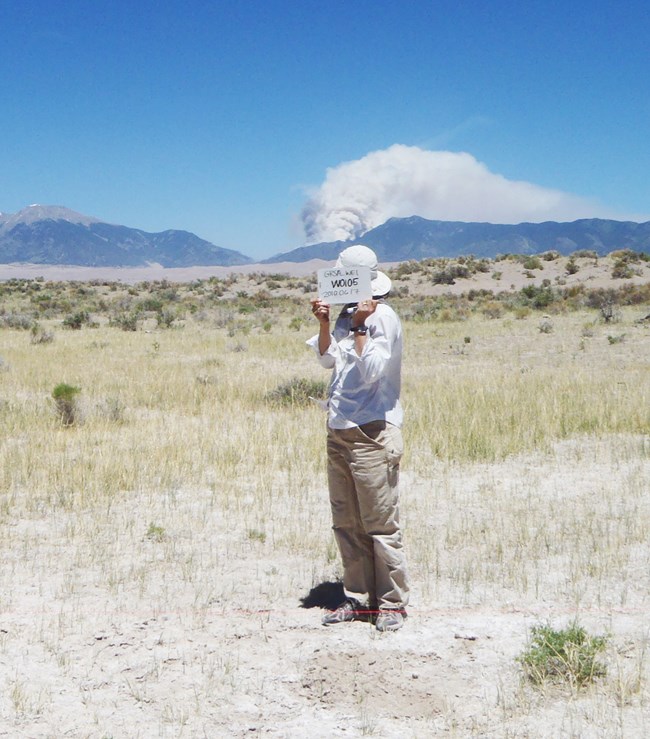Last updated: February 9, 2022
Article
Water Balance Underlies Natural Resource Conditions at Great Sand Dunes National Park and Preserve

NPS/Patrick Myers
As climate change intensifies, land managers need to understand its multifaceted effects on the ground. Yet traditional temperature and precipitation measures alone do not always accurately predict how natural resources respond. They fail to account for water storage as snow or soil moisture, and that some water goes to streams and some back into the atmosphere. The storage and movement of water creates distinctly different environments for plants and animals at different times and places. Thus, temperature and precipitation paint only a partial picture of climate change and how natural resources will respond in the future.
We used an old tool—water balance—in new ways to better understand how vegetation, stream flow, and wildfire ignitions respond to climate. Water balance is a “checking account” for water. It mathematically accounts for the input of water, where it goes, and how it leaves a place. By relating water balance to the condition of natural resources over time, we identified sensitivity to changes in climate. This is key for planning. It helps to determine which natural resources are vulnerable to climate change, and when, where, and why changes may occur.
This article summarizes newly published water balance case studies at Great Sand Dunes National Park and Preserve1. Water balance helps clarify climate impacts to stream flow, wildfire, and vegetation productivity across the wide range of elevations and vegetation types in the park.
What is Water Balance?

Adapted from Gray, S. T., and G. J. McCabe. A combined water balance and tree ring approach to understanding the potential hydrologic effects of climate change in the central Rocky Mountain region. Water Resources Research 46(5), online
Water balance tracks the fate of rain and snow after it hits the ground. Once the soil becomes saturated by melting snow, water runs off to fill streams and wetlands or moves below the root zone to become ground water. During the growing season, evaporation and transpiration remove water from the soil directly, and through plant roots, stems, and leaves back to the atmosphere. As soil dries over the growing season, less water is available to sustain vegetation. This difference between water available to plants versus how much they could use, if it were available, is called “water deficit.” As the water deficit climbs, plants become stressed and wildfires become more likely.
Case Study #1—Stream Flow

NPS/Patrick Myers
Medano Creek descends from high mountains to the park lowlands, sustaining flows for the native Rio Grande cutthroat trout and delighting summer visitors with cool water for wading and swimming. The creek also provides irrigation water. For these reasons, Medano Creek is vital to the ecology of the park, to park visitors, and even to people outside the park. We used climate data from a weather station on Medano Pass to calculate how much water enters the stream from snowmelt and rain. Our water balance model predicted stream flow in Medano Creek reasonably well up to 46 days in advance.
Potential Applications:
Anticipating the timing and quantity of low flow in dry years could help the park plan for various uses of Medano Creek’s water. Stream flow forecasts could inform the timing of recreation, management of water rights, and level of flows needed to sustain native Rio Grande cutthroat trout and the stream community.
Case Study #2—Vegetation Production (plant growth)

NPS/Patrick Myers
In dry areas of the western U.S., plant growth fluctuates as widely from year to year as the rain and snowfall it depends on. However, growth also varies with soil type, slope, aspect, and elevation. Drought tolerance interacts with all of these factors to influence how plants respond to climate. Using satellite imagery to measure “vegetation greenness” (an index of plant growth), we identified the climate and water balance variables that most strongly affected plant growth in different park vegetation types. Vegetation at different elevations responded to different aspects of climate and water balance. Generally, plant growth at high elevations was more responsive to temperature than soil moisture. Conversely, low elevation plant growth responded more to soil moisture than temperature. These different responses help managers identify which climate variables are most important for different vegetation types. From these analyses, we identified the amount of water needed to keep plants healthy and the water deficit that plants can tolerate.
Potential Applications:
With this new understanding of the climate–plant growth relationship across park vegetation types, managers can track water balance conditions as an indicator of vegetation condition. This can help identify vulnerable vegetation types before it’s too late to act and it can help inform restoration strategies.
Case Study #3—Wildfire Ignition

NPS/Billy Schweiger
Climate change has driven more frequent and severe wildfires across the western U.S. in recent years. This trend is intensifying, threatening humans and wildlife, with the potential to replace whole vegetation types with less desirable, nonnative plants. Thus, fire management is a high priority in and around the park. Knowing when conditions are dry enough to burn can require more than temperature and precipitation measures alone. Testing several water balance variables tied to dryness, we found that water deficit was a good predictor of wildfire ignitions in both grasslands and forests in and near the park.
Potential Applications:
Our water balance model uses water deficit as an early warning to inform managers about the risk of wildfire. Park managers can now track daily changes in water deficit during the fire season to inform management decisions about fire preparedness and to educate the public about current fire danger.
Management Applications
Case studies like these can catalyze the routine use of water balance by park managers for both short-term tactical decisions and long-term planning. Water balance variables support proactive management and have several added benefits:
They are broadly applicable—A growing collection of case studies apply water balance to varying resources, from spring and stream flow to plant and animal responses. Water balance can help managers understand climate impacts on plants and animals at a finer scale because it includes factors like topography and soil types that change over short distances and therefore modify the effects of temperature and precipitation.
They are readily accessible—Land managers need sound scientific information, right now, to address ongoing climate change. This approach uses commonly available climate data and a water balance model that translates temperature and precipitation into more ecologically relevant measures of water availability. These measures directly influence natural resource conditions.
They support Climate Smart Conservation—Climate Smart Conservation is an internationally used planning framework. Our water balance modeling feeds directly into this framework. It provides quantitative measures of climate exposure and sensitivity needed to understand how vulnerable resources are to climate change. This in turn helps park management adapt to continuous and ongoing changes in climate.
Learn More
Read the case studies:
1 Thoma, D. et al. 2020. Water balance as an indicator of natural resource condition: Case studies from Great Sand Dunes National Park and Preserve. Global Ecology and Conservation. https://doi.org/10.1016/j.gecco.2020.e01300
Find contacts:
The Greater Yellowstone Network
The Rocky Mountain Network
Explore the changing climate in parks:
Explore selected NPS climate monitoring programs:
Rocky Mountain I&M Network
https://www.nps.gov/im/romn/climate.htm
Greater Yellowstone I&M Network
https://www.nps.gov/im/gryn/climate.htm
Northern Colorado Plateau I&M Network
https://www.nps.gov/im/ncpn/climate.htm
Climate Change Response Program:
https://www.nps.gov/subjects/climatechange/index.htm
Download a pdf of this article.
Prepared by Sonya Daw, David Thoma, and Billy Schweiger
